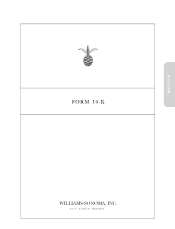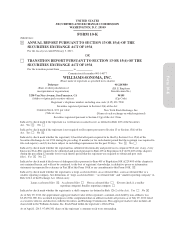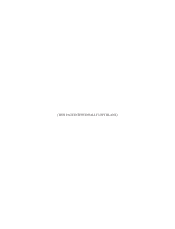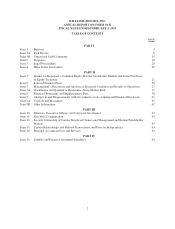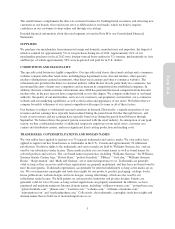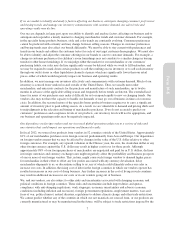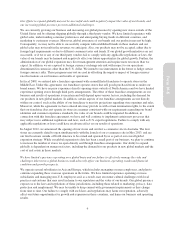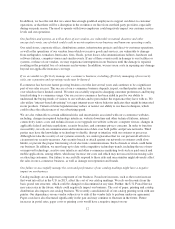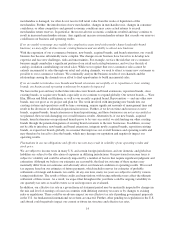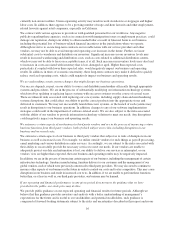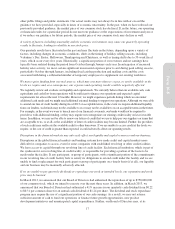Pottery Barn 2012 Annual Report Download - page 21
Download and view the complete annual report
Please find page 21 of the 2012 Pottery Barn annual report below. You can navigate through the pages in the report by either clicking on the pages listed below, or by using the keyword search tool below to find specific information within the annual report.
If we are unable to identify and analyze factors affecting our business, anticipate changing consumer preferences
and buying trends, and manage our inventory commensurate with customer demand, our sales levels and
operating results may decline.
Our success depends, in large part, upon our ability to identify and analyze factors affecting our business and to
anticipate and respond in a timely manner to changing merchandise trends and customer demands. For example,
in the specialty home products business, style and color trends are constantly evolving. Consumer preferences
cannot be predicted with certainty and may change between selling seasons. Changes in customer preferences
and buying trends may also affect our brands differently. We must be able to stay current with preferences and
trends in our brands and address the customer tastes for each of our target customer demographics. We must also
be able to identify and adjust the customer offerings in our brands to cater to customer demands. For example, a
change in customer preferences for children’s room furnishings may not correlate to a similar change in buying
trends for other home furnishings. If we misjudge either the market for our merchandise or our customers’
purchasing habits, our sales may decline significantly or may be delayed while we work to fill backorders, and
we may be required to mark down certain products to sell the resulting excess inventory or to sell such inventory
through our outlet stores or other liquidation channels at prices which are significantly lower than our retail
prices, either of which would negatively impact our business and operating results.
In addition, we must manage our inventory effectively and commensurate with customer demand. Much of our
inventory is sourced from vendors located outside of the United States. Thus, we usually must order
merchandise, and enter into contracts for the purchase and manufacture of such merchandise, up to twelve
months in advance of the applicable selling season and frequently before trends are known. The extended lead
times for many of our purchases may make it difficult for us to respond rapidly to new or changing trends. Our
vendors also may not have the capacity to handle our demands or may go out of business in times of economic
crisis. In addition, the seasonal nature of the specialty home products business requires us to carry a significant
amount of inventory prior to peak selling season. As a result, we are vulnerable to demand and pricing shifts and
to misjudgments in the selection and timing of merchandise purchases. If we do not accurately predict our
customers’ preferences and acceptance levels of our products, our inventory levels will not be appropriate, and
our business and operating results may be negatively impacted.
Our dependence on foreign vendors and our increased global operations subject us to a variety of risks and
uncertainties that could impact our operations and financial results.
In fiscal 2012, we sourced our products from vendors in 52 countries outside of the United States. Approximately
61% of our merchandise purchases were foreign-sourced, predominantly from Asia and Europe. Our dependence
on foreign vendors means that we may be affected by changes in the value of the U.S. dollar relative to other
foreign currencies. For example, any upward valuation in the Chinese yuan, the euro, the Australian dollar or any
other foreign currency against the U.S. dollar may result in higher costs to us for those goods. Although
approximately 98% of our foreign purchases of merchandise are negotiated and paid for in U.S. dollars, declines
in foreign currencies and currency exchange rates might negatively affect the profitability and business prospects
of one or more of our foreign vendors. This, in turn, might cause such foreign vendors to demand higher prices
for merchandise in their effort to offset any lost profits associated with any currency devaluation, delay
merchandise shipments to us, or discontinue selling to us, any of which could ultimately reduce our sales or
increase our costs. In addition, the rising cost of labor in the foreign countries in which our vendors operate has
resulted in increases in our costs of doing business. Any further increases in the cost of living in such countries
may result in additional increases in our costs or in our vendors going out of business.
We, and our vendors, are also subject to other risks and uncertainties associated with changing economic and
political conditions in foreign countries. These risks and uncertainties include import duties and quotas,
compliance with anti-dumping regulations, work stoppages, economic uncertainties and adverse economic
conditions (including inflation and recession), foreign government regulations, employment matters, wars and
fears of war, political unrest, natural disasters, regulations to address climate change and other trade restrictions.
We cannot predict whether any of the countries in which our raw materials are sourced from, or our products are
currently manufactured or may be manufactured in the future, will be subject to trade restrictions imposed by the
7
Form 10-K


